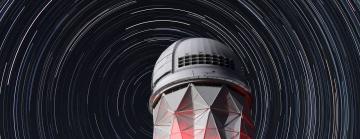Dark Energy Spectroscopic Instrument creates largest 3D map of the cosmos
DESI has already mapped out more galaxies than all previous 3D surveys combined, and it's just getting started.
The Dark Energy Spectroscopic Instrument (DESI), an international collaboration managed by the Department of Energy's Lawrence Berkeley National Laboratory, has capped off the first seven months of its survey with the largest and most detailed map of the universe ever. Yet it’s only about 10% of the way through its five-year mission.
Once completed, DESI will have mapped out an enormous volume of the universe in 3D, yielding a trove of data on the history of the universe's expansion and the growth of structure within it – and, in turn, a deeper understanding of dark energy, which drives the expansion and shapes the large-scale structure of the universe.
DESI scientists reported on the performance of the instrument and some early astrophysics results last week at a Berkeley Lab-hosted webinar called CosmoPalooza, which featured updates from other leading cosmology experiments.
DESI is an international science collaboration managed by the Department of Energy’s Lawrence Berkeley National Laboratory (Berkeley Lab) with primary funding for construction and operations from DOE’s Office of Science. Originally proposed over a decade ago, construction on the instrument started in 2015. DESI was installed at the Nicholas U. Mayall 4-meter telescope at Kitt Peak National Observatory near Tucson, Ariz. Kitt Peak National Observatory is a program of the National Science Foundation’s (NSF) NOIRLab, which the Department of Energy contracts with to operate the Mayall Telescope for the DESI survey. The instrument saw first light in late 2019, and by May 2021 it was ready to start its science survey.
“There is a lot of beauty to it,” said Berkeley Lab scientist Julien Guy, one of the CosmoPalooza speakers. “In the distribution of the galaxies in the 3D map, there are huge clusters, filaments and voids. They’re the biggest structures in the universe. But within them, you find an imprint of the very early universe, and the history of its expansion since then.”
Risa Wechsler, a cosmologist at DOE's SLAC National Accelerator Laboratory, director of the Kavli Institute for Particle Astrophysics and Cosmology, and an original DESI co-spokesperson, agreed.
"It's fantastic to see the instrument working so well," Wechsler said. "The project has come a long way to reach this point. For me personally it’s wonderful to see DESI go from the idea stage when I joined the project to a successful working instrument. The team has done amazing work to make it happen.”
Seeing dark energy’s true colors
DESI’s primary task is simple yet bold: collect detailed color images of millions of galaxies across more than a third of the sky. By breaking down the light from each galaxy into its spectrum of colors, DESI can determine how much the light has been redshifted – stretched out toward the red end of the spectrum by the expansion of the universe during the billions of years it traveled before reaching Earth. In general, the more redshifted a galaxy’s spectrum is, the farther away it is, and astrophysicists can use redshifts to build a 3D map of the cosmos.
With that map in hand, physicists can chart clusters and superclusters of galaxies. Those structures carry echoes of their initial formation, when they were just ripples in the infant cosmos. By teasing out those echoes, physicists can use DESI’s data to determine how those structures formed and how the universe expanded over time.
Understanding the expansion history is crucial. Today, about 70% of the content of the universe is dark energy, a mysterious form of energy driving the expansion of the universe ever faster. As the universe expands, more dark energy pops into existence and speeds up the expansion, in a cycle that is driving the fraction of dark energy in the universe ever upwards. Dark energy will ultimately determine the destiny of the universe – whether it will expand forever or collapse onto itself again in a sort of reverse Big Bang.
Studying dark energy has benefits beyond understanding the fate of the universe: By comparing the expansion history with the growth history, cosmologists can also check whether Einstein’s theory of general relativity holds over these immense spans of space and time.
Black holes and bright galaxies
Understanding the fate of the universe and probing general relativity will have to wait until DESI has completed more of its survey, but in the meantime, DESI is already driving breakthroughs in our understanding of the distant past, when galaxies were still young.
For example, as part of its main science goals, DESI will search for quasars, particularly bright galaxies that are among the brightest and most distant objects known. Quasars’ brightness derives from central, supermassive black holes surrounded by gas and dust that heats up as it falls into the balck hole. Because of their power, quasars make excellent probes of the early universe, and with them, DESI’s data will go back in time 11 billion years.
Durham University astronomy graduate student Victoria Fawcett and her colleagues are using DESI data to understand the evolution of quasars themselves. It’s thought that quasars start out surrounded by an envelope of dust, which reddens the light they give off, like the sun through haze. As they age, they drive off this dust and become bluer. But it has been hard to test this theory because of the paucity of data on red quasars. DESI is changing that, finding more quasars than any prior survey, with an estimated 2.4 million quasars expected in the final survey data.
The benefits aren’t limited to quasars. “We’re finding quite a lot of exotic systems,” Fawcett says, “including large samples of rare objects that we just haven’t been able to study in detail before.”
Meanwhile, DESI has so much data-gathering capacity that some of it is being dedicated to pilot projects that could guide what the experiment will focus on once the main survey is done. In one of those projects, Elise Darragh-Ford, a Stanford University graduate student working with Wechsler, will map out dwarf galaxies relatively close to us – that is, from about 20 to 150 megaparsecs, or between 65 to about 500 million light years away. Studying these objects, on the opposite end of the distance scale from quasars, will help researchers better understand the formation of the small-scale structure of the universe and ultimately help probe the nature of dark matter.
“We’ve been working to make the most of everything we’re measuring,” Wechsler said. “DESI is such a powerful instrument that you can do all kinds of things with the data.”
There’s more to come for DESI. The survey has already cataloged over 7.5 million galaxies and is adding more at a rate of over a million a month. In November 2021 alone, DESI cataloged redshifts from 2.5 million galaxies. By the end of its run in 2026, DESI is expected to have over 35 million galaxies in its catalog, enabling an enormous variety of cosmology and astrophysics research.
“The early data is just beautiful," Wechsler said. "This is going to be a big leap in our ability to measure dark energy, map the structure of the Universe, and so much more."
Editor's Note: This article is based on a press release from DESI.
DESI is supported by the DOE Office of Science and by the National Energy Research Scientific Computing Center, a DOE Office of Science user facility. Additional support for DESI is provided by the U.S. National Science Foundation, the Science and Technologies Facilities Council of the United Kingdom, the Gordon and Betty Moore Foundation, the Heising-Simons Foundation, the French Alternative Energies and Atomic Energy Commission (CEA), the National Council of Science and Technology of Mexico, the Ministry of Economy of Spain, and the DESI member institutions.
The DESI collaboration is honored to be permitted to conduct scientific research on Iolkam Du’ag (Kitt Peak), a mountain with particular significance to the Tohono O’odham Nation.
For questions or comments, contact the SLAC Office of Communications at communications@slac.stanford.edu.
SLAC is a vibrant multiprogram laboratory that explores how the universe works at the biggest, smallest and fastest scales and invents powerful tools used by scientists around the globe. With research spanning particle physics, astrophysics and cosmology, materials, chemistry, bio- and energy sciences and scientific computing, we help solve real-world problems and advance the interests of the nation.
SLAC is operated by Stanford University for the U.S. Department of Energy’s Office of Science. The Office of Science is the single largest supporter of basic research in the physical sciences in the United States and is working to address some of the most pressing challenges of our time.






